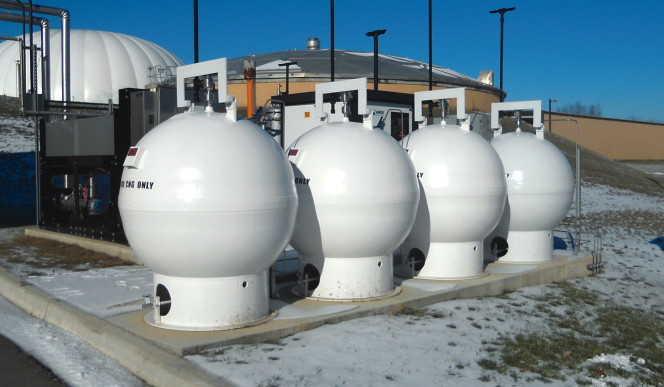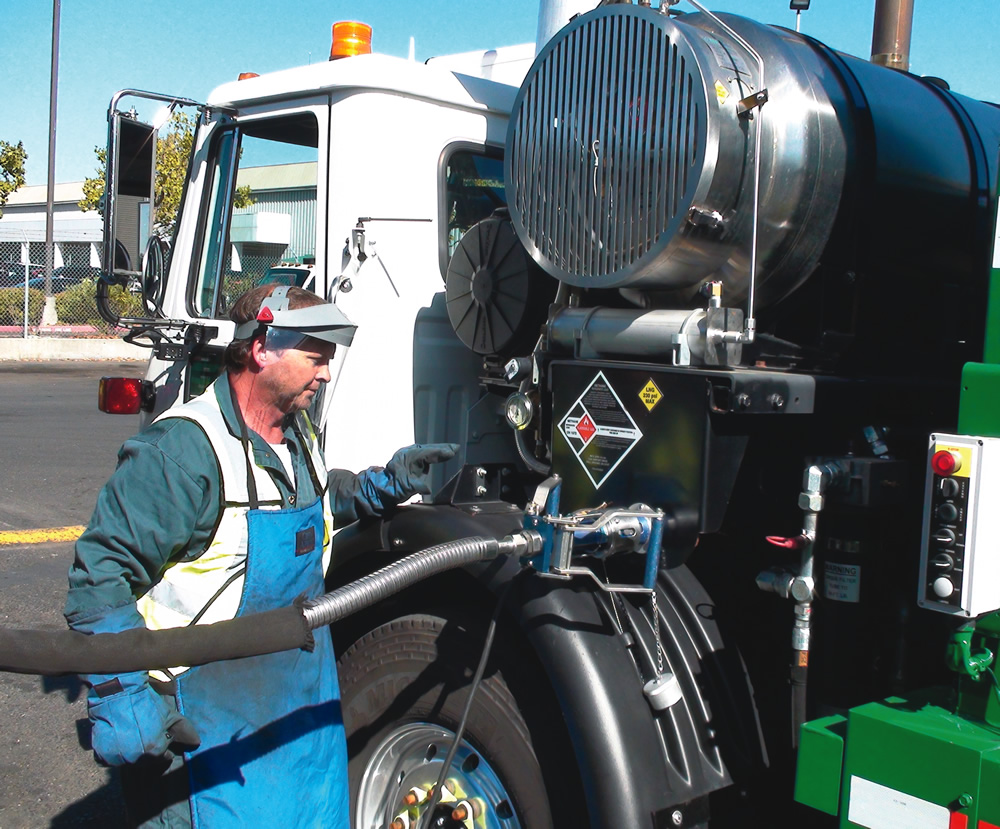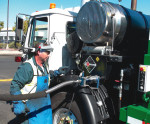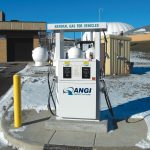Studies “conservatively” estimate renewable natural gas could replace 16 percent of the 38 billion gallons of diesel fuel consumed annually by the 10 million fleet trucks and buses on American roads.
Peter Gorrie
BioCycle March/April 2014

Conditioned and compressed renewable natural gas is stored (above) for use as a fuel for city-owned pickup trucks in Janesville, Wisconsin.
Every day across the Midwest, milk is hauled to processing plants in heavy-duty tanker trucks powered by fuel originating from manure generated by 11,500 dairy cattle at Fair Oaks Farms in northwestern Indiana. In California, fuel derived from the Altamont landfill in Livermore, keeps more than 300 garbage trucks moving along their routes.
In both cases, the fuel is renewable natural gas, upgraded from the biogas generated by the Fair Oaks anaerobic digester and the Altamont Landfill. Proponents say the projects are among a growing number that show it’s ready to roll as a fuel for vehicles. “There’s a great upward trajectory,” says David Cox, director of operations at the Coalition for Renewable Natural Gas, the main industry lobby group.
While renewable natural gas, also called RNG or biomethane, offers economic and environmental benefits, it needs substantial support through regulations and incentives to reach its potential as a transportation fuel; in particular, as a replacement for diesel trucks and buses. The potential is immense, the New York-based environmental research group Energy Vision states in a recent report, Turning Waste Into Vehicle Fuel: “Every year, U.S. households, institutions, factories, and farms throw away enough garbage, yard trimmings, crop residues, and other organic wastes to, if turned into a source of energy, power almost every urban truck and bus fleet in the nation.”
Recent studies by the American Gas Foundation and American Petroleum Council “conservatively” estimate RNG, using commercially proven technologies, could replace 16 percent of the 38 billion gallons of diesel fuel consumed annually by the 10 million fleet trucks and buses on American roads and highways. Those uses account for nearly one-quarter of all U.S. transportation fuel.
RNG is produced by stripping the carbon dioxide, hydrogen sulfide and other impurities from biogas — generated by anaerobic digesters at wastewater treatment plants, farms, commercial facilities and at landfills, — until it’s more than 95 percent methane. That makes it identical to, and interchangeable with, conventional natural gas. RNG can be compressed and injected into the pipeline grid to displace some of the conventional supply. Compared to natural gas, RNG bears the added expense of facilities to generate or collect and upgrade biogas. As a result, its price is about 50 percent above conventional gas. And with the current low prices for natural gas, it is difficult to compete directly as a substitute.
However, RNG is substantially cheaper than diesel. This fact, combined with environmental advantages such as 90 percent fewer greenhouse gas emissions than diesel or gasoline, and 60 percent less than conventional natural gas, makes RNG an attractive transportation fuel. “Compared to other end-use alternatives, utilization of RNG as a transportation fuel yields the greatest environmental benefit, especially on a greenhouse gas emissions lifecycle basis,” says the Coalition’s Cox.
Still, Energy Vision lists just 12 U.S. projects that produce RNG as vehicle fuel. They’re based at seven landfills, two wastewater treatment plants, two projects that generate biogas from food and other organic wastes and the dairy farm. “It’s really just emerged as a viable option in the last few years, but interest appears to be growing,” says Energy Vision president Joanna Underwood. The Coalition forecasts that number will grow to 22 this year and, says Cox, with “stability in the current transportation fuels policies at the federal and state level, we expect to see exponential growth … beyond 2014.”
Either number represents a minuscule fraction of American transportation fuel consumption, and of RNG’s potential. The seven landfill-based projects leave another 490 large U.S. sites that collect biogas, and those, in turn, are just one-third of the all landfills in the U.S. The U.S. Department of Energy Alternative Fuels Data Center lists 1,329 natural gas fueling stations across the country. Only a few dozen dispense RNG.
Fueling Stations
RNG and conventional compressed natural gas (CNG) are dispensed from the same type of fueling stations and can be combined in them. Each station requires a device to pull gas from its source and dry it, compressors, storage tanks, temperature-compensation controls and dispensing systems.
There are two types of RNG/CNG fueling options: “Slow fill” or “time fill” stations take up to 12 hours for a fill. They’re suited to fleets, such as waste collection or local delivery, where vehicles follow regular daily routes, then, return to a base to be refuelled overnight. The stations cost from about $360,000 to $1.4 million, installed, depending on their daily fuelling capacity, according to ANGI Energy Systems, North America’s leading supplier of natural gas vehicle fuelling equipment. Fleets with irregular demands require “fast fill” stations, which dispense the gas under higher pressure and fill a vehicle’s tank in minutes. These stations cost about $500,000 to $2.2 million depending on capacity. Costs vary with customer specifications, specific fueling requirements and special installation issues such as permits and site preparation, notes ANGI.
The moving parts and operation of stations are straightforward, but real estate, pipeline interconnect and government regulations depending on location can present hurdles, explains Mark Maloney, director of business development at AMP Americas, which installed the upgrading equipment and fuelling stations at Fair Oaks. Its fast-fill stations for semi-trailers cost $1.8 to $2.2 million, he says. The biggest operating expense is electricity to power the pumps, compressors and other equipment. The price is highly variable, depending on location and utility regulations.
Trucks that run on natural gas cost 20 to 25 percent more than equivalent diesels. With new engines having greatly improved performance, sales are increasing by 25 percent annually, according to Pike Research, with waste collection and transfer trucks now the dominant market. The situation is a classic chicken-and-egg dilemma for those promoting both conventional and renewable natural gas as a vehicle fuel: The lack of infrastructure discourages investment in RNG production while the limited investment discourages infrastructure development.
Most RNG producers fuel their own vehicles or those that regularly visit their site. Waste Management Inc. puts RNG from the Altamont landfill into its own garbage trucks. At Fair Oaks Farms, the gas is dispensed to trucks operated by Ruan Transportation Management Systems, the contracted hauler for milk delivery. The RNG produced at the Janesville, Wisconsin wastewater treatment plant fuels five city vehicles from its RNG facility. Utilizing RNG saves about the equivalent of $1 a gallon compared with diesel fuel, but it’s more expensive than using conventional natural gas. Facilities attempt to close the gap with additional revenue sources, such as tipping fees or the sale of digestate products and biogas-generated electricity. For example, Janesville earns $118,000 annually from electricity sales compared with saving just $3,100 through displacing diesel with RNG.
Federal And State Incentives
The other, and for now indispensible, way to compensate for RNG’s higher cost is through regulations that require it to be used, or grants, tax breaks and other financial support. At the federal level, the U.S. EPA provides the industry’s major support through its Renewable Fuel Standard, or RFS, a complex set of regulations requiring that the U.S. transportation fuel supply include a certain percentage — in practice, about 10 percent — renewable fuels, such as ethanol, biodiesel and RNG.
Most states back development of natural gas vehicles in general, or RNG in particular. Measures include grants, tax breaks, low-interest loans, renewable portfolio standards or policies such as bans on landfilling organic wastes that increase the feedstock supply for anaerobic digesters.
California, with its stringent air quality regulations, is a crucial market for RNG fuel. Its Low Carbon Fuel Standard is leading manufacturers to develop a variety of vehicles, including electric and fuel-cell cars, that emit few or no greenhouse gases. The rule also opens the door for RNG since, from production to consumption, it has the lowest carbon footprint of any commercially viable transportation fuel. California’s standard and the RFS combine to let Clean Energy Renewable Fuels, which produces RNG for vehicles under the Redeem brand, sell RNG at the same price as conventional natural gas, says Harrison Clay, company president. Clean Energy Renewable Fuels is a subsidiary of North America’s largest supplier of natural gas for vehicles. In addition, the state’s Public Utilities Commission recently voted to ease a 1988 regulation that banned all gas originating in landfills from the natural gas pipeline grid. The revision will allow RNG that meets strict standards into the grid.
RNG proponents say it’s crucial that supports remain stable and predictable. Volatility makes it difficult to plan and finance projects. The Renewable Fuel Standard is a key case in point. The current regulation, adopted in 2007, set targets that increase every year until 2022. The EPA can adjust it annually. The regulation sets minimum volumes for three categories of fuel — biodiesel, cellulosic biofuel and advanced biofuel. RNG is in the last category, which also includes corn ethanol. Fuel quantities are measured in EGEs — the amount of energy compared with a gallon of ethanol.
To achieve its goal, the standard requires companies that produce, refine or import gasoline for use in the contiguous 48 states to pay for a share of the mandated renewable supply proportional to the volume of conventional fuel they produce. They must fulfill this obligation, whether or not the renewable fuel is actually produced. This is done through Renewable Identification Numbers, or RINs, which are generated with each gallon or batch of renewable fuel. The petroleum companies, known as “obligated parties,” have several options for complying with the standard: They can buy renewable fuels to blend with their own products, in which case the RINs are transferred with that supply. They can simply buy RINs, which amount to credits that let them pay to do nothing. They can apply for a one-year delay in meeting their obligation. Or, they can apply for a waiver to reduce their obligation.
The ability to buy RINs has created a RIN trading market: Renewable fuel producers sell them to brokers who, in turn, sell them to obligated parties. They’re an important revenue source for most RNG projects. Cox of the Coalition for RNG calls this income “a major driver of industry success, especially in transportation fuels.”
The advanced biofuel RFS was a solid boost to RNG, since hitting the steadily rising targets would not only require development of new supplies but also, by pushing up the value of RINs, generate increasing revenue for the producers. But late last year, the EPA proposed a substantial cut in the mandatory volumes, in effect, capping them at 2011 levels for this year and 2015. The proposed change was necessary, the agency said, because renewable energy producers couldn’t make enough fuel to meet the original standard.
This claim about not being able to produce enough advanced biofuels is primarily focused around corn ethanol and cellulosic ethanol. In particular, corn ethanol, which comprises 10 percent of almost all gasoline sold in the United States, appears to have hit what’s called the “blendwall.” American gasoline consumption is dropping and there’s less need for as much ethanol as the original standard anticipated.
In addition, development of cellulosic ethanol, produced from crop residues, biosolids and other nonfood plant materials, has been far slower than expected, leaving the “cellulosic biofuels” category virtually empty. The proposed reduction “is intended to put the program on a manageable trajectory while still allowing for growth,“ the EPA explained.
The agency had already been forced to reduce the standard for previous years. It rescinded the 2011 and 2012 volumes for cellulosic biofuel after a successful court challenge by the American Petroleum Institute (API), the industry trade association, which argued the volume requirement was unrealistically high. It is also reconsidering the 2013 standard for that category. EPA also faces waiver applications from API as well as the American Fuel and Petroleum Manufacturers and several refining companies that would cut the number of RINs they must acquire.
In any event, the Coalition for RNG argues that while the EPA might be correct about the outlook for other fuels, it shouldn’t impose the same restraint on RNG, which, with sufficient support, could be ramped up well beyond even the previous standard. This year, it says, the industry could produce RNG equivalent to 176 million gallons of ethanol — far above the EPA’s proposed 35 to 54 million gallons.
As many feared, the RIN values fell to about 20 cents after the EPA’s announcement, after climbing to $1.30 last year, when it appeared the standard would steadily rise over the next decade. Clay of Clean Energy calls the EPA’s proposal “the single most important determinant of what the volume will be. Once you’ve established a number as the target, not much more than that will be produced if RIN values are low due to a reduced mandate and reduced RIN demand.” Clean Energy, which is considering 15 new RNG projects, could produce and sell anywhere in the United States with a RIN price of 40 or 50 cents, he says. At 20 cents, “we’ll see less of these projects come to fruition.”
The reduction has “done a lot of damage to the market,” notes Maloney of AMP Americas. If the proposal were enacted, “work in developing additional (RNG) projects would be suspended.”
Scott DeWees, a Project Manager at the Western Washington State Clean Cities Coalition (WWSCCC) agrees. “The impact could be dramatic,” he says. The group is part of the U.S. Department of Energy’s Clean Cities program, a network of 100 coalitions across the country, in which fuel suppliers, local governments, vehicle manufacturers, national laboratories, state and federal agencies, and other organizations join to implement alternative transportation solutions in their communities.
The WWSCCC includes only one RNG fuel producer but “we also have several agricultural and food waste digester projects we think are great candidates for vehicle RNG,” DeWees explains. “In 2012 and 2013, we started to see the market respond to the RFS program and begin developing projects targeting vehicle fueling. We think many projects would not be developed without this market support. The (proposal) immediately put all project development on hold. Even with a favorable outcome from the final rule … there will be lasting anxiety in the capital markets on which these projects depend.”
The EPA also proposes that RNG produced at landfills be shifted to the cellulosic biofuels category, which, while currently undersubscribed, is allocated by far the biggest production increases over the next decade. It also generates special RIN credits, worth about 50 cents an ethanol gallon. That would help the projects based at landfills but not those, like Fair Oaks, that make RNG from digester biogas. They’d be worse off since the EPA is likely to drop the RFS for advanced biofuels if it adds landfill RNG to the cellulosic category.
The standard should push development, not simply reflect existing conditions, Underwood says. “What you get is what you go for.”


















